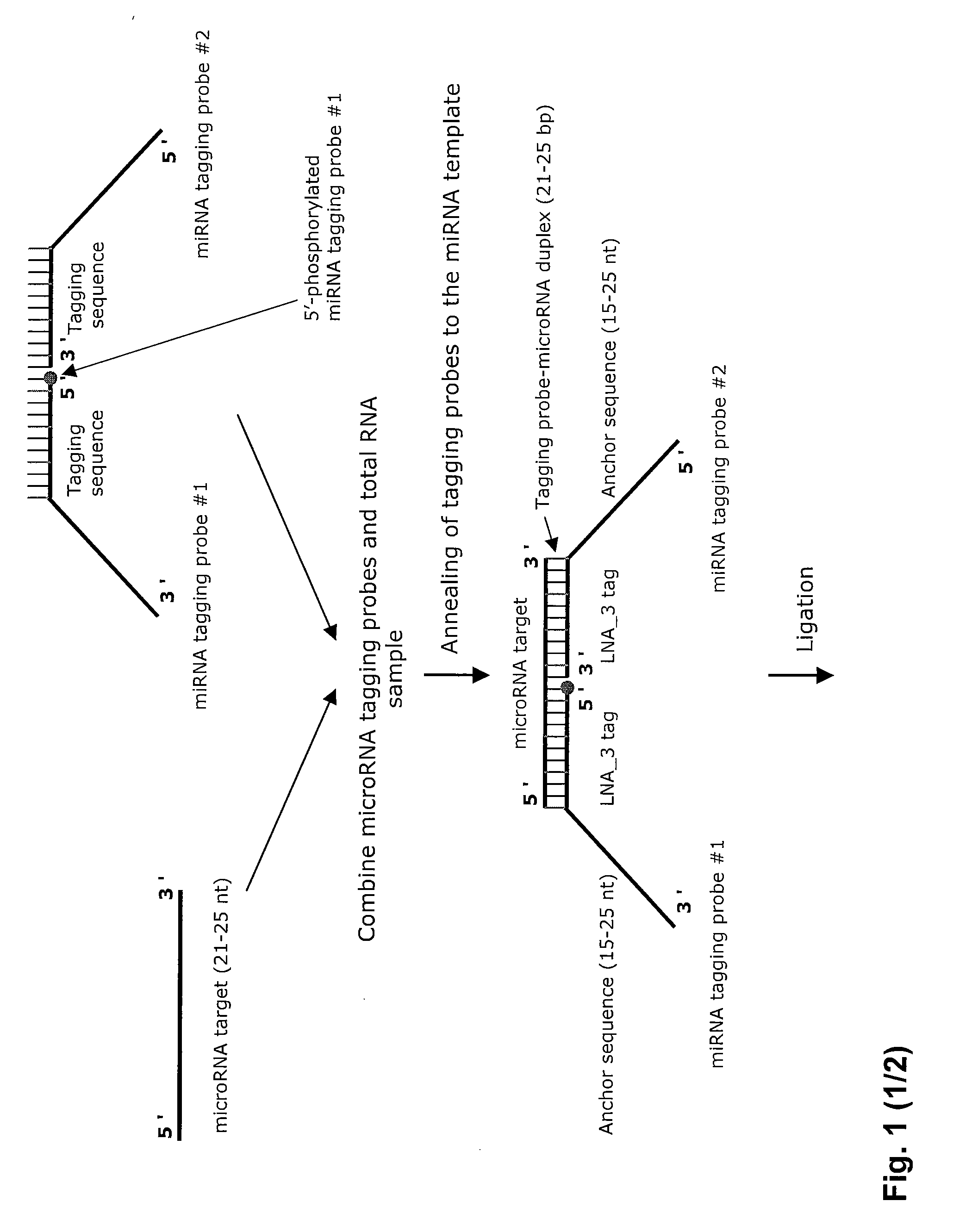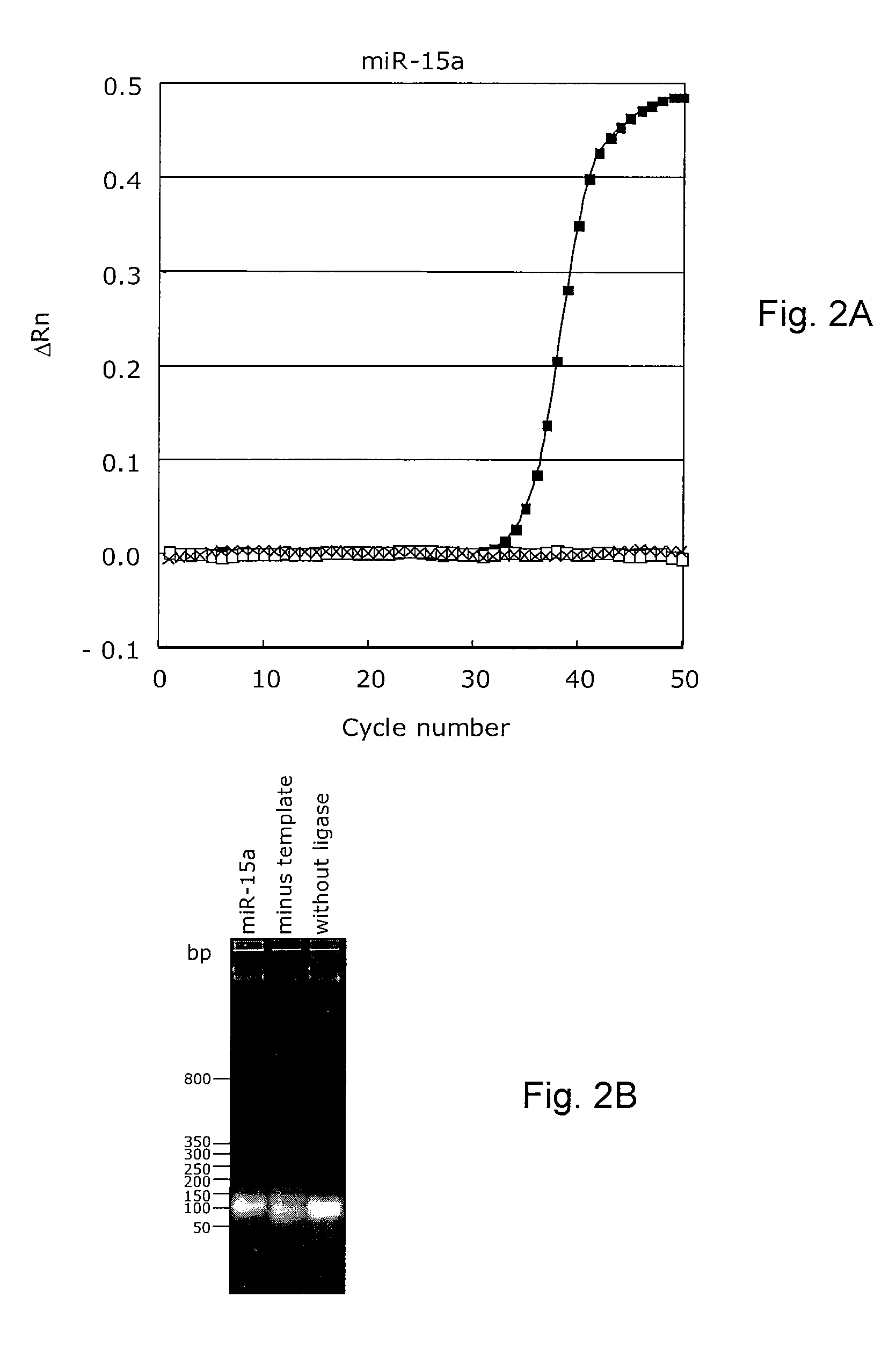Novel methods for quantification of micrornas and small interfering rnas
a microrna and small interfering technology, applied in the field of target nucleotide sequence quantification, can solve the problems of low throughput and poor sensitivity, poor sensitivity of rare targets, and include of micrornas, and achieve high usefulness and application, high sensitivity and specific hybridization and ligation, and high sensitivity
- Summary
- Abstract
- Description
- Claims
- Application Information
AI Technical Summary
Benefits of technology
Problems solved by technology
Method used
Image
Examples
example 1
[0267]Real-time quantitative PCR assay for the human miR-15a microRNA target sequence.
[0268]The sequence-specific LNA-modified microRNA tagging probes were annealed and ligated. The ligated templates were subsequently detected using real-time PCR, anchor PCR primers and an LNA-modified dual-labelled detection probe for the miR-15a microRNA using a minus template as a negative control. The specificity of the reaction was tested using a reaction without ligase. The threshold cycle (Ct), which represents the PCR cycle at which an increase in reporter fluorescence above a baseline signal can first be detected, for the ligated microRNA probes, using the miR-15a microRNA template was 35.0 (FIG. 2A), whereas no Ct values were detectable for the negative control experiments (minus template and minus ligase, respectively). The normalized reporter signal (Rn) is measured over the PCR reaction, which represents the fluorescence signal of the reporter dye divided by the fluorescence signal of t...
example 2
[0269]Real-time quantitative PCR assay for the human miR-15a microRNA target sequence and the corresponding DNA 3′-blocked target.
[0270]The RNA template was replaced by a DNA template, which was chemically blocked with a phosphate at the 3′-end. Without addition of ligase in the ligation reaction, the blocked DNA template could not be detected in the LNA sequence-specific real-time PCR assay. The Ct values for the RNA template and the DNA template were 35.0 and 33.3, respectively (FIG. 3).
example 3
[0271]Specificity of the real-time quantitative PCR assays for the human miR-15a and human miR-16 microRNA target sequences.
[0272]Sequence-specific microRNA target sequence recognition of the method of invention was assessed by using the miR-15a microRNA target in comparison with the human miR-16 target that has 72% sequence identity with the miR-15a target sequence. Neither the minus template control nor the no template control (NTC) in the real-time PCR reaction were shown to give any signals. Using the hybridization conditions for the annealing of the LNA-modified miR-15a target sequence-specific tagging probes as described above towards the miR-15a target resulted in a Ct value of 36.2, whereas the use of the same tagging probes for the highly homologous miR-16 resulted in a Ct value of 39.9, corresponding to a 13-fold discriminative difference (FIG. 4).
PUM
| Property | Measurement | Unit |
|---|---|---|
| temperatures | aaaaa | aaaaa |
| temperature | aaaaa | aaaaa |
| temperature | aaaaa | aaaaa |
Abstract
Description
Claims
Application Information
 Login to View More
Login to View More - R&D
- Intellectual Property
- Life Sciences
- Materials
- Tech Scout
- Unparalleled Data Quality
- Higher Quality Content
- 60% Fewer Hallucinations
Browse by: Latest US Patents, China's latest patents, Technical Efficacy Thesaurus, Application Domain, Technology Topic, Popular Technical Reports.
© 2025 PatSnap. All rights reserved.Legal|Privacy policy|Modern Slavery Act Transparency Statement|Sitemap|About US| Contact US: help@patsnap.com



